Posted on December 11th, 2014 by Mary Lord
 Light-emitting diodes illuminate everything from traffic signals to shimmering sculptures like this one by Makoto Tojiki. But the researchers whose early 1990s breakthrough – a blue-light LED – made today’s energy-saving white lamps possible toiled mostly in the shadows… until they won the Nobel Prize for Physics in 2014.
Light-emitting diodes illuminate everything from traffic signals to shimmering sculptures like this one by Makoto Tojiki. But the researchers whose early 1990s breakthrough – a blue-light LED – made today’s energy-saving white lamps possible toiled mostly in the shadows… until they won the Nobel Prize for Physics in 2014.
No longer. In September, the Royal Swedish Academy of Sciences awarded the Nobel Prize in physics to Isamu Akasaki of Meijo University in Nagoya, Japan, Hiroshi Amano of Nagoya University, and Shuji Nakamura, a professor of materials and co-director of the Solid State Lighting and Energy Electronics Center at the University of California, Santa Barbara.
Read More
Filed under: Special Features | Comments Off on Blue LED Beams Nobel Fame
Tags: blue LED, discovery, Electrical, electricity, Hiroshi Amano, Innovation, invention, Isamu Akasaki, light, Nobel Prize, Physics, Shuji Nakamura
Posted on August 28th, 2014 by Mary Lord
 Are your students vexed by vectors or mystified by electricity? MIT’s Open Courseware offers a series of videos designed to help students learn these and other pivotal concepts in science, technology, engineering, mathematics that are the building blocks of many engineering curricula.
Are your students vexed by vectors or mystified by electricity? MIT’s Open Courseware offers a series of videos designed to help students learn these and other pivotal concepts in science, technology, engineering, mathematics that are the building blocks of many engineering curricula.
Read More
Filed under: For Teachers, Grades 9-12, K-12 Outreach Programs, Special Features, Web Resources | Comments Off on MIT Videos Convey Key STEM Concepts
Tags: Biology, calculus, Chemistry, electricity, Engineering, integral, Mathematics, MIT, motions and forces, Open Courseware, Physics, probability, Problem Solving, STEM videos, vectors
Posted on July 25th, 2014 by Mary Lord
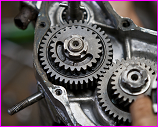 In this activity, students in grades 4 to 8 use LEGO spur gears to learn about different types of gears and how they are used in many engineering devices, including bicycles, to change the speed, torque, and direction of a power source.
In this activity, students in grades 4 to 8 use LEGO spur gears to learn about different types of gears and how they are used in many engineering devices, including bicycles, to change the speed, torque, and direction of a power source.
Read More
Filed under: Class Activities, Grades 6-8, Grades K-5, Lesson Plans | Comments Off on What Are Gears?
Tags: bicycle, Class Activities, gears, Grades 6-8, Grades K-5, LEGOS, Mathematics, Mechanical engineering, Physics, simple machines, speed, torque
Posted on June 19th, 2013 by Mary Lord
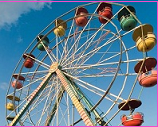 In this activity, teams of students in grades K-12 learn about the history and engineering behind Ferris wheels by constructing a working model using pasta, glue, and teabags.
In this activity, teams of students in grades K-12 learn about the history and engineering behind Ferris wheels by constructing a working model using pasta, glue, and teabags.
Read More
Filed under: Class Activities, Grades 6-8, Grades 6-8, Grades 9-12, Grades 9-12, Grades K-5, Grades K-5, Lesson Plans | Comments Off on Build a Big Wheel
Tags: Class Activities, Ferris wheel, Grades 6-8, Grades 9-12, Grades K-5, London eye, motions and forces, Physics
Posted on March 18th, 2013 by Mary Lord
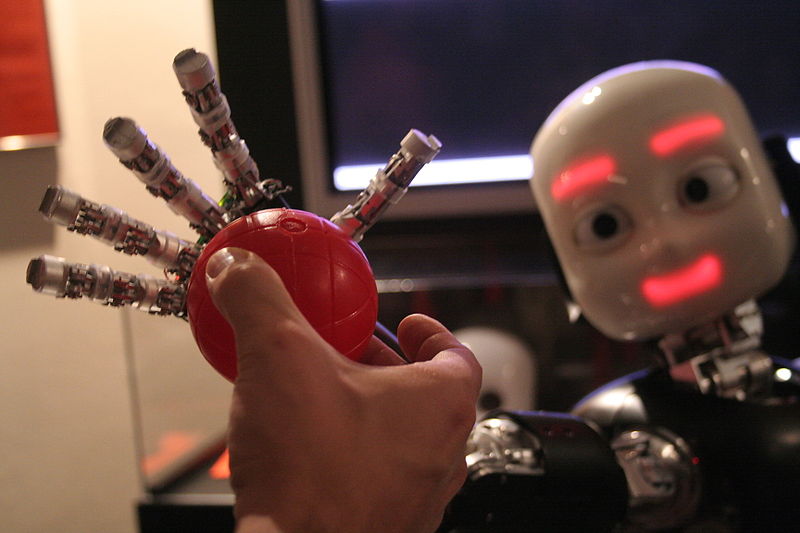 In this activity, students in grades 5 to 12 learn about accuracy, precision, and simple machines by working in teams to design and build a robotic basketball “player” that can nail a free-throw shot three times in a row.
In this activity, students in grades 5 to 12 learn about accuracy, precision, and simple machines by working in teams to design and build a robotic basketball “player” that can nail a free-throw shot three times in a row.
Read More
Filed under: Class Activities, Grades 6-8, Grades 6-8, Grades 6-8, Grades 9-12, Grades 9-12, Grades 9-12, Lesson Plans | 2 Comments »
Tags: accuracy, basketball, biomechanical engineering, biomechanics, catapult, Class Activities, Engineering, lever, Mathematics, percentages, Physics, precision, projectile, Robotics, simple machines, Sports Engineering, statistics
Posted on October 16th, 2012 by Mary Lord
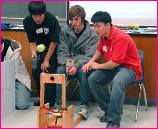 Students in grades 1 to 6 follow the engineering design process to build and test a catapult that launches projectiles, such as marshmallow “pumpkins.” They then make changes to improve their launcher’s aim and distance it can hurl the projectile.
Students in grades 1 to 6 follow the engineering design process to build and test a catapult that launches projectiles, such as marshmallow “pumpkins.” They then make changes to improve their launcher’s aim and distance it can hurl the projectile.
Read More
Filed under: Class Activities, Grades 6-8, Grades K-5, Lesson Plans | Comments Off on Target Practice: Pumpkin Launcher
Tags: catapult, Design, Elementary Education, Engineering Design, forces and motion, Halloween, levers, motions and forces, Physics, simple machines
Posted on September 19th, 2012 by Mary Lord
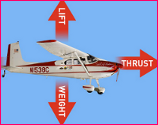 Why do airplanes fly? What is genetic engineering? To help K-12 students and teachers understand such topics, MIT has tapped its 10,000 brilliant young scholars to create engaging, short videos to supplement classroom instruction.
Why do airplanes fly? What is genetic engineering? To help K-12 students and teachers understand such topics, MIT has tapped its 10,000 brilliant young scholars to create engaging, short videos to supplement classroom instruction.
Read More
Filed under: K-12 Outreach Programs, Web Resources | Comments Off on MIT+ Offers K-12 STEM Videos
Tags: Aeronautics, Biology, Chemistry, Engineering, genetic engineering, Internet Resources, Lesson Plans, Math, MIT, MIT+K12, Physics, Resources for Teachers, STEM videos, supplemental materials, Teacher Resources, Videos, Web Resources
Posted on September 11th, 2011 by Mary Lord
 In this lesson, teams of students in grades 4 – 8 learn about basic aerodynamics by constructing a rocket from a balloon propelled along a guide-string. They use this model to learn about Newton’s three laws of motion, examining the effect of different forces on the motion of the rocket.
In this lesson, teams of students in grades 4 – 8 learn about basic aerodynamics by constructing a rocket from a balloon propelled along a guide-string. They use this model to learn about Newton’s three laws of motion, examining the effect of different forces on the motion of the rocket.
Read More
Filed under: Grades 6-8, Grades K-5, Lesson Plans | 2 Comments »
Tags: Aerospace, aerospace lessons, balloon rocket, forces, NASA, Newton's, Physics, rockets
Posted on July 31st, 2011 by Mary Lord
 In this lesson, students in grades 3 – 12 will explore the engineering design process by building a device that can launch a ping-pong ball high enough for them to catch it.
In this lesson, students in grades 3 – 12 will explore the engineering design process by building a device that can launch a ping-pong ball high enough for them to catch it.
Read More
Filed under: Class Activities, Grades 6-8, Grades 6-8, Grades 9-12, Grades 9-12, Grades K-5, Grades K-5, Lesson Plans | 1 Comment »
Tags: baseball, Design Squad, Energy, Engineering Design, force, levers, motion, NGSS aligned, Physics, simple machines
 Light-emitting diodes illuminate everything from traffic signals to shimmering sculptures like this one by Makoto Tojiki. But the researchers whose early 1990s breakthrough – a blue-light LED – made today’s energy-saving white lamps possible toiled mostly in the shadows… until they won the Nobel Prize for Physics in 2014.
Light-emitting diodes illuminate everything from traffic signals to shimmering sculptures like this one by Makoto Tojiki. But the researchers whose early 1990s breakthrough – a blue-light LED – made today’s energy-saving white lamps possible toiled mostly in the shadows… until they won the Nobel Prize for Physics in 2014.








 Are your students vexed by vectors or mystified by electricity? MIT’s Open Courseware offers a series of videos designed to help students learn these and other pivotal concepts in science, technology, engineering, mathematics that are the building blocks of many engineering curricula.
Are your students vexed by vectors or mystified by electricity? MIT’s Open Courseware offers a series of videos designed to help students learn these and other pivotal concepts in science, technology, engineering, mathematics that are the building blocks of many engineering curricula. In this activity, students in grades 4 to 8 use LEGO spur gears to learn about different types of gears and how they are used in many engineering devices, including bicycles, to change the speed, torque, and direction of a power source.
In this activity, students in grades 4 to 8 use LEGO spur gears to learn about different types of gears and how they are used in many engineering devices, including bicycles, to change the speed, torque, and direction of a power source. In this activity, teams of students in grades K-12 learn about the history and engineering behind Ferris wheels by constructing a working model using pasta, glue, and teabags.
In this activity, teams of students in grades K-12 learn about the history and engineering behind Ferris wheels by constructing a working model using pasta, glue, and teabags. Students in grades 1 to 6 follow the engineering design process to build and test a catapult that launches projectiles, such as marshmallow “pumpkins.” They then make changes to improve their launcher’s aim and distance it can hurl the projectile.
Students in grades 1 to 6 follow the engineering design process to build and test a catapult that launches projectiles, such as marshmallow “pumpkins.” They then make changes to improve their launcher’s aim and distance it can hurl the projectile. Why do airplanes fly? What is genetic engineering? To help K-12 students and teachers understand such topics, MIT has tapped its 10,000 brilliant young scholars to create engaging, short videos to supplement classroom instruction.
Why do airplanes fly? What is genetic engineering? To help K-12 students and teachers understand such topics, MIT has tapped its 10,000 brilliant young scholars to create engaging, short videos to supplement classroom instruction. In this lesson, teams of students in grades 4 – 8 learn about basic aerodynamics by constructing a rocket from a balloon propelled along a guide-string. They use this model to learn about Newton’s three laws of motion, examining the effect of different forces on the motion of the rocket.
In this lesson, teams of students in grades 4 – 8 learn about basic aerodynamics by constructing a rocket from a balloon propelled along a guide-string. They use this model to learn about Newton’s three laws of motion, examining the effect of different forces on the motion of the rocket. In this lesson, students in grades 3 – 12 will explore the engineering design process by building a device that can launch a ping-pong ball high enough for them to catch it.
In this lesson, students in grades 3 – 12 will explore the engineering design process by building a device that can launch a ping-pong ball high enough for them to catch it.